Analyzing Financial Resources and Decisions: Hardwood Ltd Report
VerifiedAdded on 2020/02/14
|18
|4433
|28
Report
AI Summary
This comprehensive report examines the financial resource management of Hardwood Ltd, a medium-sized furniture manufacturer. It explores various sources of finance, including short, medium, and long-term options such as trade credit, debentures, retained earnings, hire purchase, leasing, share capital, and bank loans, analyzing their implications and recommending the most appropriate choices for the company's expansion plans. The report emphasizes the importance of financial planning, detailing the information needs of decision-makers like shareholders, employees, suppliers, and financial institutions. It analyzes the impact of finance on financial statements, including balance sheets, profit and loss accounts, and cash flow statements. Furthermore, the report includes an analysis of a cash budget, cost calculations, and investment appraisal techniques such as net present value, internal rate of return and ratio analysis, providing a holistic view of Hardwood Ltd's financial strategy and performance.
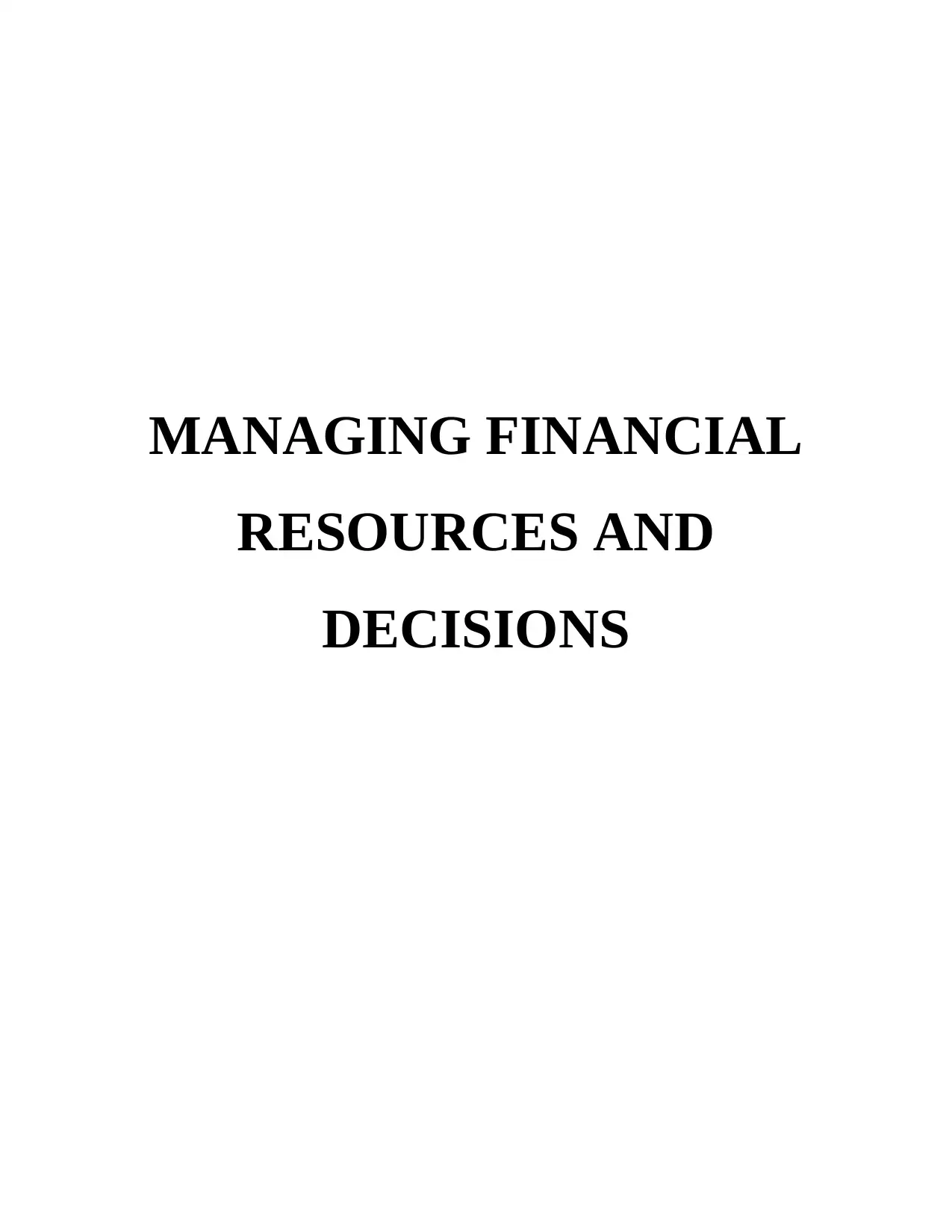
MANAGING FINANCIAL
RESOURCES AND
DECISIONS
RESOURCES AND
DECISIONS
Paraphrase This Document
Need a fresh take? Get an instant paraphrase of this document with our AI Paraphraser
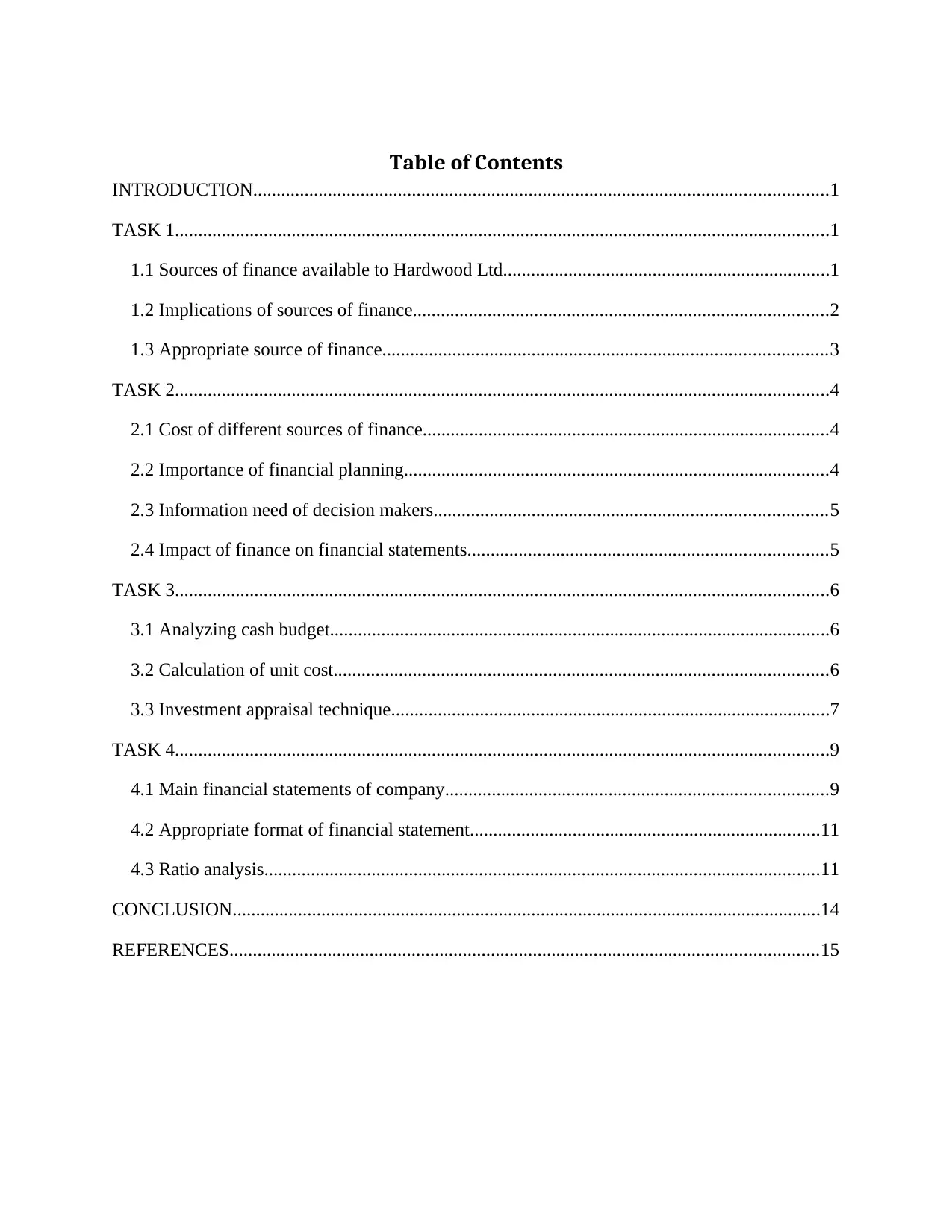
Table of Contents
INTRODUCTION...........................................................................................................................1
TASK 1............................................................................................................................................1
1.1 Sources of finance available to Hardwood Ltd......................................................................1
1.2 Implications of sources of finance.........................................................................................2
1.3 Appropriate source of finance...............................................................................................3
TASK 2............................................................................................................................................4
2.1 Cost of different sources of finance.......................................................................................4
2.2 Importance of financial planning...........................................................................................4
2.3 Information need of decision makers....................................................................................5
2.4 Impact of finance on financial statements.............................................................................5
TASK 3............................................................................................................................................6
3.1 Analyzing cash budget...........................................................................................................6
3.2 Calculation of unit cost..........................................................................................................6
3.3 Investment appraisal technique..............................................................................................7
TASK 4............................................................................................................................................9
4.1 Main financial statements of company..................................................................................9
4.2 Appropriate format of financial statement...........................................................................11
4.3 Ratio analysis.......................................................................................................................11
CONCLUSION..............................................................................................................................14
REFERENCES..............................................................................................................................15
INTRODUCTION...........................................................................................................................1
TASK 1............................................................................................................................................1
1.1 Sources of finance available to Hardwood Ltd......................................................................1
1.2 Implications of sources of finance.........................................................................................2
1.3 Appropriate source of finance...............................................................................................3
TASK 2............................................................................................................................................4
2.1 Cost of different sources of finance.......................................................................................4
2.2 Importance of financial planning...........................................................................................4
2.3 Information need of decision makers....................................................................................5
2.4 Impact of finance on financial statements.............................................................................5
TASK 3............................................................................................................................................6
3.1 Analyzing cash budget...........................................................................................................6
3.2 Calculation of unit cost..........................................................................................................6
3.3 Investment appraisal technique..............................................................................................7
TASK 4............................................................................................................................................9
4.1 Main financial statements of company..................................................................................9
4.2 Appropriate format of financial statement...........................................................................11
4.3 Ratio analysis.......................................................................................................................11
CONCLUSION..............................................................................................................................14
REFERENCES..............................................................................................................................15
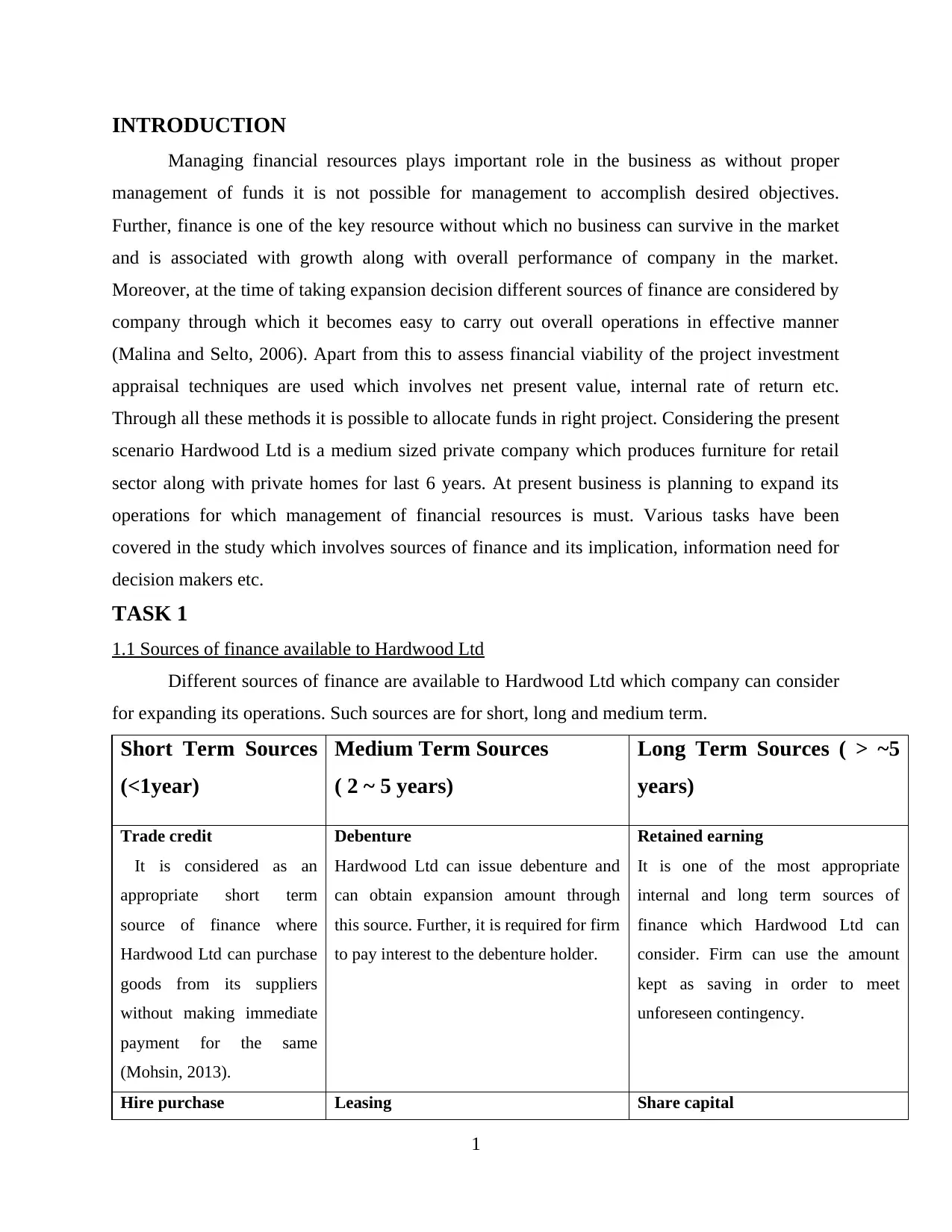
INTRODUCTION
Managing financial resources plays important role in the business as without proper
management of funds it is not possible for management to accomplish desired objectives.
Further, finance is one of the key resource without which no business can survive in the market
and is associated with growth along with overall performance of company in the market.
Moreover, at the time of taking expansion decision different sources of finance are considered by
company through which it becomes easy to carry out overall operations in effective manner
(Malina and Selto, 2006). Apart from this to assess financial viability of the project investment
appraisal techniques are used which involves net present value, internal rate of return etc.
Through all these methods it is possible to allocate funds in right project. Considering the present
scenario Hardwood Ltd is a medium sized private company which produces furniture for retail
sector along with private homes for last 6 years. At present business is planning to expand its
operations for which management of financial resources is must. Various tasks have been
covered in the study which involves sources of finance and its implication, information need for
decision makers etc.
TASK 1
1.1 Sources of finance available to Hardwood Ltd
Different sources of finance are available to Hardwood Ltd which company can consider
for expanding its operations. Such sources are for short, long and medium term.
Short Term Sources
(<1year)
Medium Term Sources
( 2 ~ 5 years)
Long Term Sources ( > ~5
years)
Trade credit
It is considered as an
appropriate short term
source of finance where
Hardwood Ltd can purchase
goods from its suppliers
without making immediate
payment for the same
(Mohsin, 2013).
Debenture
Hardwood Ltd can issue debenture and
can obtain expansion amount through
this source. Further, it is required for firm
to pay interest to the debenture holder.
Retained earning
It is one of the most appropriate
internal and long term sources of
finance which Hardwood Ltd can
consider. Firm can use the amount
kept as saving in order to meet
unforeseen contingency.
Hire purchase Leasing Share capital
1
Managing financial resources plays important role in the business as without proper
management of funds it is not possible for management to accomplish desired objectives.
Further, finance is one of the key resource without which no business can survive in the market
and is associated with growth along with overall performance of company in the market.
Moreover, at the time of taking expansion decision different sources of finance are considered by
company through which it becomes easy to carry out overall operations in effective manner
(Malina and Selto, 2006). Apart from this to assess financial viability of the project investment
appraisal techniques are used which involves net present value, internal rate of return etc.
Through all these methods it is possible to allocate funds in right project. Considering the present
scenario Hardwood Ltd is a medium sized private company which produces furniture for retail
sector along with private homes for last 6 years. At present business is planning to expand its
operations for which management of financial resources is must. Various tasks have been
covered in the study which involves sources of finance and its implication, information need for
decision makers etc.
TASK 1
1.1 Sources of finance available to Hardwood Ltd
Different sources of finance are available to Hardwood Ltd which company can consider
for expanding its operations. Such sources are for short, long and medium term.
Short Term Sources
(<1year)
Medium Term Sources
( 2 ~ 5 years)
Long Term Sources ( > ~5
years)
Trade credit
It is considered as an
appropriate short term
source of finance where
Hardwood Ltd can purchase
goods from its suppliers
without making immediate
payment for the same
(Mohsin, 2013).
Debenture
Hardwood Ltd can issue debenture and
can obtain expansion amount through
this source. Further, it is required for firm
to pay interest to the debenture holder.
Retained earning
It is one of the most appropriate
internal and long term sources of
finance which Hardwood Ltd can
consider. Firm can use the amount
kept as saving in order to meet
unforeseen contingency.
Hire purchase Leasing Share capital
1
⊘ This is a preview!⊘
Do you want full access?
Subscribe today to unlock all pages.

Trusted by 1+ million students worldwide
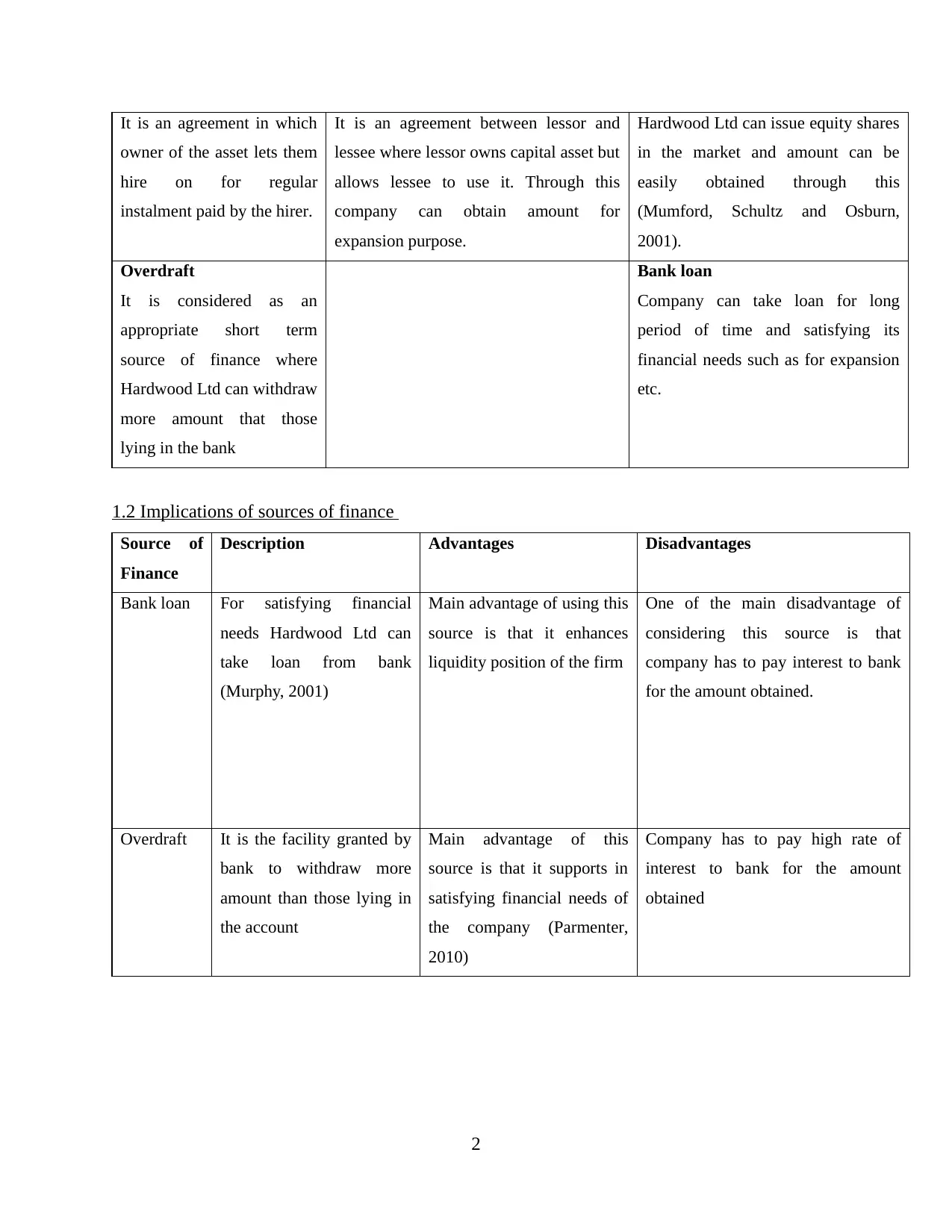
It is an agreement in which
owner of the asset lets them
hire on for regular
instalment paid by the hirer.
It is an agreement between lessor and
lessee where lessor owns capital asset but
allows lessee to use it. Through this
company can obtain amount for
expansion purpose.
Hardwood Ltd can issue equity shares
in the market and amount can be
easily obtained through this
(Mumford, Schultz and Osburn,
2001).
Overdraft
It is considered as an
appropriate short term
source of finance where
Hardwood Ltd can withdraw
more amount that those
lying in the bank
Bank loan
Company can take loan for long
period of time and satisfying its
financial needs such as for expansion
etc.
1.2 Implications of sources of finance
Source of
Finance
Description Advantages Disadvantages
Bank loan For satisfying financial
needs Hardwood Ltd can
take loan from bank
(Murphy, 2001)
Main advantage of using this
source is that it enhances
liquidity position of the firm
One of the main disadvantage of
considering this source is that
company has to pay interest to bank
for the amount obtained.
Overdraft It is the facility granted by
bank to withdraw more
amount than those lying in
the account
Main advantage of this
source is that it supports in
satisfying financial needs of
the company (Parmenter,
2010)
Company has to pay high rate of
interest to bank for the amount
obtained
2
owner of the asset lets them
hire on for regular
instalment paid by the hirer.
It is an agreement between lessor and
lessee where lessor owns capital asset but
allows lessee to use it. Through this
company can obtain amount for
expansion purpose.
Hardwood Ltd can issue equity shares
in the market and amount can be
easily obtained through this
(Mumford, Schultz and Osburn,
2001).
Overdraft
It is considered as an
appropriate short term
source of finance where
Hardwood Ltd can withdraw
more amount that those
lying in the bank
Bank loan
Company can take loan for long
period of time and satisfying its
financial needs such as for expansion
etc.
1.2 Implications of sources of finance
Source of
Finance
Description Advantages Disadvantages
Bank loan For satisfying financial
needs Hardwood Ltd can
take loan from bank
(Murphy, 2001)
Main advantage of using this
source is that it enhances
liquidity position of the firm
One of the main disadvantage of
considering this source is that
company has to pay interest to bank
for the amount obtained.
Overdraft It is the facility granted by
bank to withdraw more
amount than those lying in
the account
Main advantage of this
source is that it supports in
satisfying financial needs of
the company (Parmenter,
2010)
Company has to pay high rate of
interest to bank for the amount
obtained
2
Paraphrase This Document
Need a fresh take? Get an instant paraphrase of this document with our AI Paraphraser
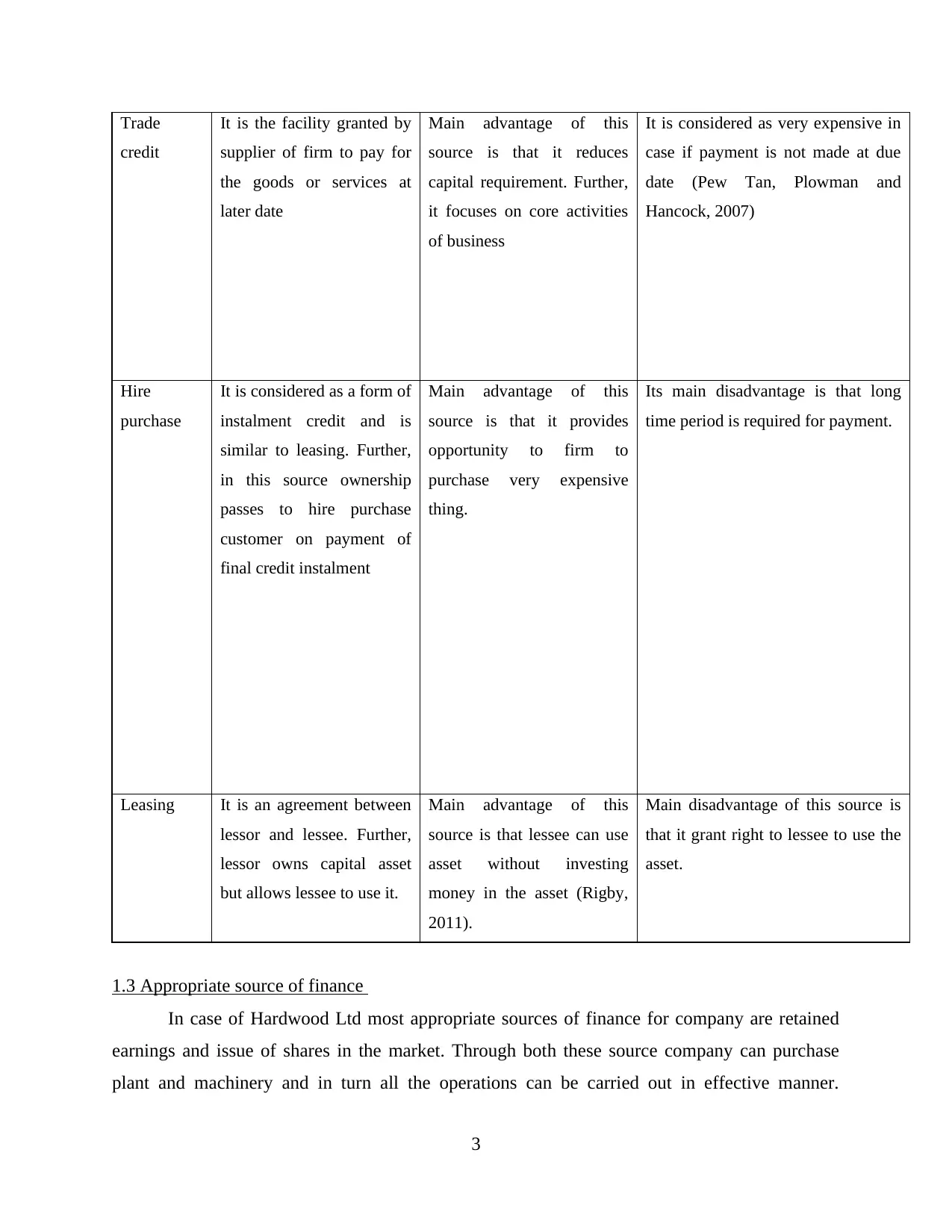
Trade
credit
It is the facility granted by
supplier of firm to pay for
the goods or services at
later date
Main advantage of this
source is that it reduces
capital requirement. Further,
it focuses on core activities
of business
It is considered as very expensive in
case if payment is not made at due
date (Pew Tan, Plowman and
Hancock, 2007)
Hire
purchase
It is considered as a form of
instalment credit and is
similar to leasing. Further,
in this source ownership
passes to hire purchase
customer on payment of
final credit instalment
Main advantage of this
source is that it provides
opportunity to firm to
purchase very expensive
thing.
Its main disadvantage is that long
time period is required for payment.
Leasing It is an agreement between
lessor and lessee. Further,
lessor owns capital asset
but allows lessee to use it.
Main advantage of this
source is that lessee can use
asset without investing
money in the asset (Rigby,
2011).
Main disadvantage of this source is
that it grant right to lessee to use the
asset.
1.3 Appropriate source of finance
In case of Hardwood Ltd most appropriate sources of finance for company are retained
earnings and issue of shares in the market. Through both these source company can purchase
plant and machinery and in turn all the operations can be carried out in effective manner.
3
credit
It is the facility granted by
supplier of firm to pay for
the goods or services at
later date
Main advantage of this
source is that it reduces
capital requirement. Further,
it focuses on core activities
of business
It is considered as very expensive in
case if payment is not made at due
date (Pew Tan, Plowman and
Hancock, 2007)
Hire
purchase
It is considered as a form of
instalment credit and is
similar to leasing. Further,
in this source ownership
passes to hire purchase
customer on payment of
final credit instalment
Main advantage of this
source is that it provides
opportunity to firm to
purchase very expensive
thing.
Its main disadvantage is that long
time period is required for payment.
Leasing It is an agreement between
lessor and lessee. Further,
lessor owns capital asset
but allows lessee to use it.
Main advantage of this
source is that lessee can use
asset without investing
money in the asset (Rigby,
2011).
Main disadvantage of this source is
that it grant right to lessee to use the
asset.
1.3 Appropriate source of finance
In case of Hardwood Ltd most appropriate sources of finance for company are retained
earnings and issue of shares in the market. Through both these source company can purchase
plant and machinery and in turn all the operations can be carried out in effective manner.
3
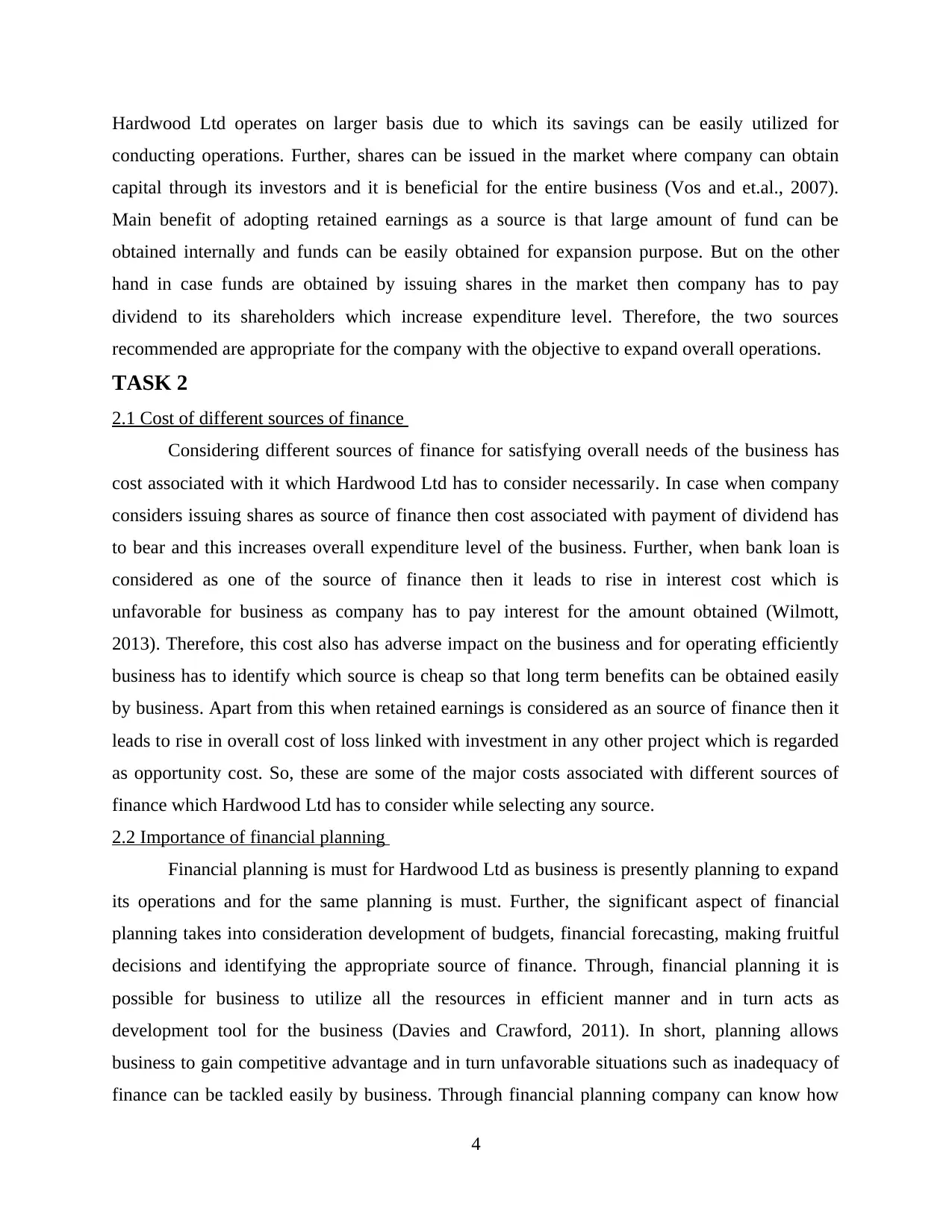
Hardwood Ltd operates on larger basis due to which its savings can be easily utilized for
conducting operations. Further, shares can be issued in the market where company can obtain
capital through its investors and it is beneficial for the entire business (Vos and et.al., 2007).
Main benefit of adopting retained earnings as a source is that large amount of fund can be
obtained internally and funds can be easily obtained for expansion purpose. But on the other
hand in case funds are obtained by issuing shares in the market then company has to pay
dividend to its shareholders which increase expenditure level. Therefore, the two sources
recommended are appropriate for the company with the objective to expand overall operations.
TASK 2
2.1 Cost of different sources of finance
Considering different sources of finance for satisfying overall needs of the business has
cost associated with it which Hardwood Ltd has to consider necessarily. In case when company
considers issuing shares as source of finance then cost associated with payment of dividend has
to bear and this increases overall expenditure level of the business. Further, when bank loan is
considered as one of the source of finance then it leads to rise in interest cost which is
unfavorable for business as company has to pay interest for the amount obtained (Wilmott,
2013). Therefore, this cost also has adverse impact on the business and for operating efficiently
business has to identify which source is cheap so that long term benefits can be obtained easily
by business. Apart from this when retained earnings is considered as an source of finance then it
leads to rise in overall cost of loss linked with investment in any other project which is regarded
as opportunity cost. So, these are some of the major costs associated with different sources of
finance which Hardwood Ltd has to consider while selecting any source.
2.2 Importance of financial planning
Financial planning is must for Hardwood Ltd as business is presently planning to expand
its operations and for the same planning is must. Further, the significant aspect of financial
planning takes into consideration development of budgets, financial forecasting, making fruitful
decisions and identifying the appropriate source of finance. Through, financial planning it is
possible for business to utilize all the resources in efficient manner and in turn acts as
development tool for the business (Davies and Crawford, 2011). In short, planning allows
business to gain competitive advantage and in turn unfavorable situations such as inadequacy of
finance can be tackled easily by business. Through financial planning company can know how
4
conducting operations. Further, shares can be issued in the market where company can obtain
capital through its investors and it is beneficial for the entire business (Vos and et.al., 2007).
Main benefit of adopting retained earnings as a source is that large amount of fund can be
obtained internally and funds can be easily obtained for expansion purpose. But on the other
hand in case funds are obtained by issuing shares in the market then company has to pay
dividend to its shareholders which increase expenditure level. Therefore, the two sources
recommended are appropriate for the company with the objective to expand overall operations.
TASK 2
2.1 Cost of different sources of finance
Considering different sources of finance for satisfying overall needs of the business has
cost associated with it which Hardwood Ltd has to consider necessarily. In case when company
considers issuing shares as source of finance then cost associated with payment of dividend has
to bear and this increases overall expenditure level of the business. Further, when bank loan is
considered as one of the source of finance then it leads to rise in interest cost which is
unfavorable for business as company has to pay interest for the amount obtained (Wilmott,
2013). Therefore, this cost also has adverse impact on the business and for operating efficiently
business has to identify which source is cheap so that long term benefits can be obtained easily
by business. Apart from this when retained earnings is considered as an source of finance then it
leads to rise in overall cost of loss linked with investment in any other project which is regarded
as opportunity cost. So, these are some of the major costs associated with different sources of
finance which Hardwood Ltd has to consider while selecting any source.
2.2 Importance of financial planning
Financial planning is must for Hardwood Ltd as business is presently planning to expand
its operations and for the same planning is must. Further, the significant aspect of financial
planning takes into consideration development of budgets, financial forecasting, making fruitful
decisions and identifying the appropriate source of finance. Through, financial planning it is
possible for business to utilize all the resources in efficient manner and in turn acts as
development tool for the business (Davies and Crawford, 2011). In short, planning allows
business to gain competitive advantage and in turn unfavorable situations such as inadequacy of
finance can be tackled easily by business. Through financial planning company can know how
4
⊘ This is a preview!⊘
Do you want full access?
Subscribe today to unlock all pages.

Trusted by 1+ million students worldwide
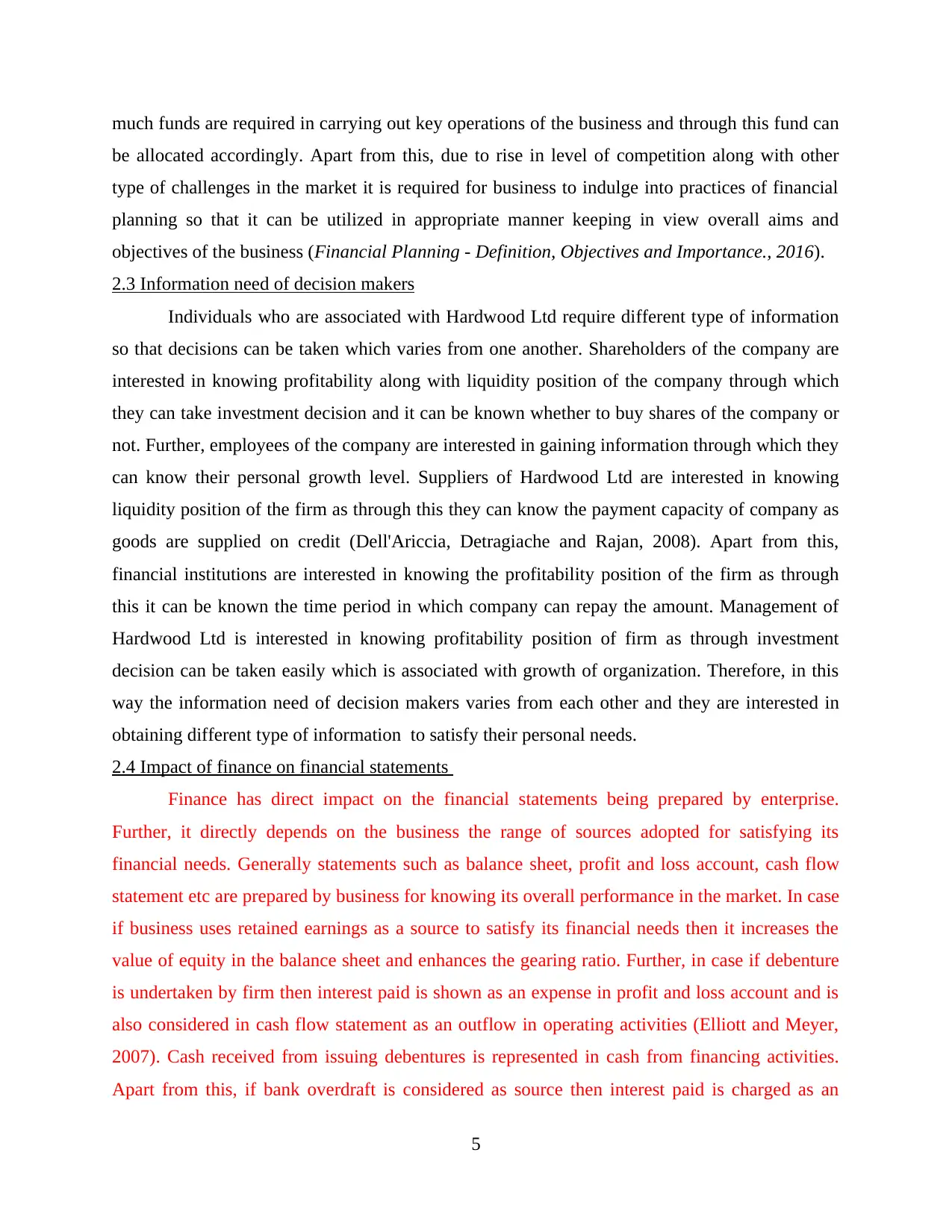
much funds are required in carrying out key operations of the business and through this fund can
be allocated accordingly. Apart from this, due to rise in level of competition along with other
type of challenges in the market it is required for business to indulge into practices of financial
planning so that it can be utilized in appropriate manner keeping in view overall aims and
objectives of the business (Financial Planning - Definition, Objectives and Importance., 2016).
2.3 Information need of decision makers
Individuals who are associated with Hardwood Ltd require different type of information
so that decisions can be taken which varies from one another. Shareholders of the company are
interested in knowing profitability along with liquidity position of the company through which
they can take investment decision and it can be known whether to buy shares of the company or
not. Further, employees of the company are interested in gaining information through which they
can know their personal growth level. Suppliers of Hardwood Ltd are interested in knowing
liquidity position of the firm as through this they can know the payment capacity of company as
goods are supplied on credit (Dell'Ariccia, Detragiache and Rajan, 2008). Apart from this,
financial institutions are interested in knowing the profitability position of the firm as through
this it can be known the time period in which company can repay the amount. Management of
Hardwood Ltd is interested in knowing profitability position of firm as through investment
decision can be taken easily which is associated with growth of organization. Therefore, in this
way the information need of decision makers varies from each other and they are interested in
obtaining different type of information to satisfy their personal needs.
2.4 Impact of finance on financial statements
Finance has direct impact on the financial statements being prepared by enterprise.
Further, it directly depends on the business the range of sources adopted for satisfying its
financial needs. Generally statements such as balance sheet, profit and loss account, cash flow
statement etc are prepared by business for knowing its overall performance in the market. In case
if business uses retained earnings as a source to satisfy its financial needs then it increases the
value of equity in the balance sheet and enhances the gearing ratio. Further, in case if debenture
is undertaken by firm then interest paid is shown as an expense in profit and loss account and is
also considered in cash flow statement as an outflow in operating activities (Elliott and Meyer,
2007). Cash received from issuing debentures is represented in cash from financing activities.
Apart from this, if bank overdraft is considered as source then interest paid is charged as an
5
be allocated accordingly. Apart from this, due to rise in level of competition along with other
type of challenges in the market it is required for business to indulge into practices of financial
planning so that it can be utilized in appropriate manner keeping in view overall aims and
objectives of the business (Financial Planning - Definition, Objectives and Importance., 2016).
2.3 Information need of decision makers
Individuals who are associated with Hardwood Ltd require different type of information
so that decisions can be taken which varies from one another. Shareholders of the company are
interested in knowing profitability along with liquidity position of the company through which
they can take investment decision and it can be known whether to buy shares of the company or
not. Further, employees of the company are interested in gaining information through which they
can know their personal growth level. Suppliers of Hardwood Ltd are interested in knowing
liquidity position of the firm as through this they can know the payment capacity of company as
goods are supplied on credit (Dell'Ariccia, Detragiache and Rajan, 2008). Apart from this,
financial institutions are interested in knowing the profitability position of the firm as through
this it can be known the time period in which company can repay the amount. Management of
Hardwood Ltd is interested in knowing profitability position of firm as through investment
decision can be taken easily which is associated with growth of organization. Therefore, in this
way the information need of decision makers varies from each other and they are interested in
obtaining different type of information to satisfy their personal needs.
2.4 Impact of finance on financial statements
Finance has direct impact on the financial statements being prepared by enterprise.
Further, it directly depends on the business the range of sources adopted for satisfying its
financial needs. Generally statements such as balance sheet, profit and loss account, cash flow
statement etc are prepared by business for knowing its overall performance in the market. In case
if business uses retained earnings as a source to satisfy its financial needs then it increases the
value of equity in the balance sheet and enhances the gearing ratio. Further, in case if debenture
is undertaken by firm then interest paid is shown as an expense in profit and loss account and is
also considered in cash flow statement as an outflow in operating activities (Elliott and Meyer,
2007). Cash received from issuing debentures is represented in cash from financing activities.
Apart from this, if bank overdraft is considered as source then interest paid is charged as an
5
Paraphrase This Document
Need a fresh take? Get an instant paraphrase of this document with our AI Paraphraser
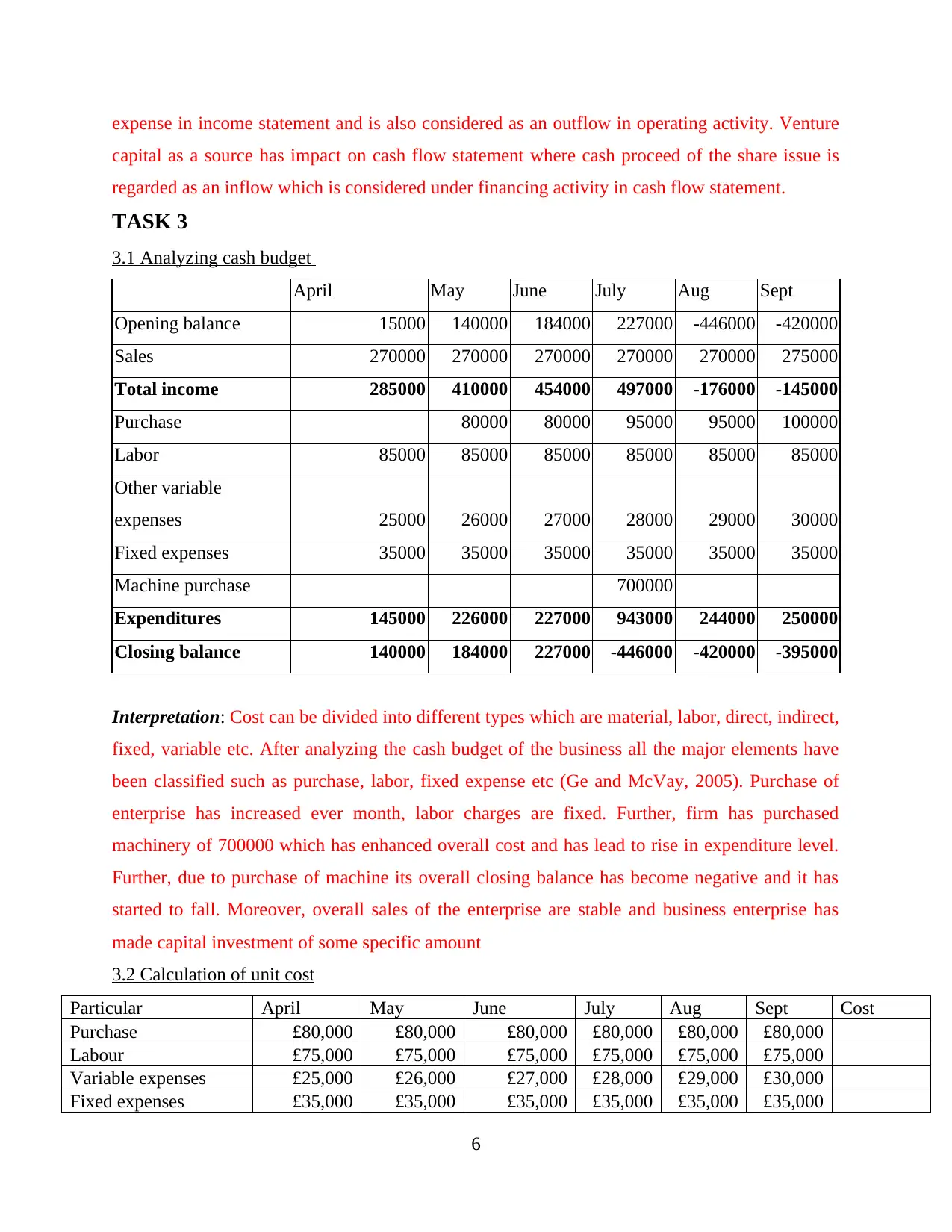
expense in income statement and is also considered as an outflow in operating activity. Venture
capital as a source has impact on cash flow statement where cash proceed of the share issue is
regarded as an inflow which is considered under financing activity in cash flow statement.
TASK 3
3.1 Analyzing cash budget
April May June July Aug Sept
Opening balance 15000 140000 184000 227000 -446000 -420000
Sales 270000 270000 270000 270000 270000 275000
Total income 285000 410000 454000 497000 -176000 -145000
Purchase 80000 80000 95000 95000 100000
Labor 85000 85000 85000 85000 85000 85000
Other variable
expenses 25000 26000 27000 28000 29000 30000
Fixed expenses 35000 35000 35000 35000 35000 35000
Machine purchase 700000
Expenditures 145000 226000 227000 943000 244000 250000
Closing balance 140000 184000 227000 -446000 -420000 -395000
Interpretation: Cost can be divided into different types which are material, labor, direct, indirect,
fixed, variable etc. After analyzing the cash budget of the business all the major elements have
been classified such as purchase, labor, fixed expense etc (Ge and McVay, 2005). Purchase of
enterprise has increased ever month, labor charges are fixed. Further, firm has purchased
machinery of 700000 which has enhanced overall cost and has lead to rise in expenditure level.
Further, due to purchase of machine its overall closing balance has become negative and it has
started to fall. Moreover, overall sales of the enterprise are stable and business enterprise has
made capital investment of some specific amount
3.2 Calculation of unit cost
Particular April May June July Aug Sept Cost
Purchase £80,000 £80,000 £80,000 £80,000 £80,000 £80,000
Labour £75,000 £75,000 £75,000 £75,000 £75,000 £75,000
Variable expenses £25,000 £26,000 £27,000 £28,000 £29,000 £30,000
Fixed expenses £35,000 £35,000 £35,000 £35,000 £35,000 £35,000
6
capital as a source has impact on cash flow statement where cash proceed of the share issue is
regarded as an inflow which is considered under financing activity in cash flow statement.
TASK 3
3.1 Analyzing cash budget
April May June July Aug Sept
Opening balance 15000 140000 184000 227000 -446000 -420000
Sales 270000 270000 270000 270000 270000 275000
Total income 285000 410000 454000 497000 -176000 -145000
Purchase 80000 80000 95000 95000 100000
Labor 85000 85000 85000 85000 85000 85000
Other variable
expenses 25000 26000 27000 28000 29000 30000
Fixed expenses 35000 35000 35000 35000 35000 35000
Machine purchase 700000
Expenditures 145000 226000 227000 943000 244000 250000
Closing balance 140000 184000 227000 -446000 -420000 -395000
Interpretation: Cost can be divided into different types which are material, labor, direct, indirect,
fixed, variable etc. After analyzing the cash budget of the business all the major elements have
been classified such as purchase, labor, fixed expense etc (Ge and McVay, 2005). Purchase of
enterprise has increased ever month, labor charges are fixed. Further, firm has purchased
machinery of 700000 which has enhanced overall cost and has lead to rise in expenditure level.
Further, due to purchase of machine its overall closing balance has become negative and it has
started to fall. Moreover, overall sales of the enterprise are stable and business enterprise has
made capital investment of some specific amount
3.2 Calculation of unit cost
Particular April May June July Aug Sept Cost
Purchase £80,000 £80,000 £80,000 £80,000 £80,000 £80,000
Labour £75,000 £75,000 £75,000 £75,000 £75,000 £75,000
Variable expenses £25,000 £26,000 £27,000 £28,000 £29,000 £30,000
Fixed expenses £35,000 £35,000 £35,000 £35,000 £35,000 £35,000
6
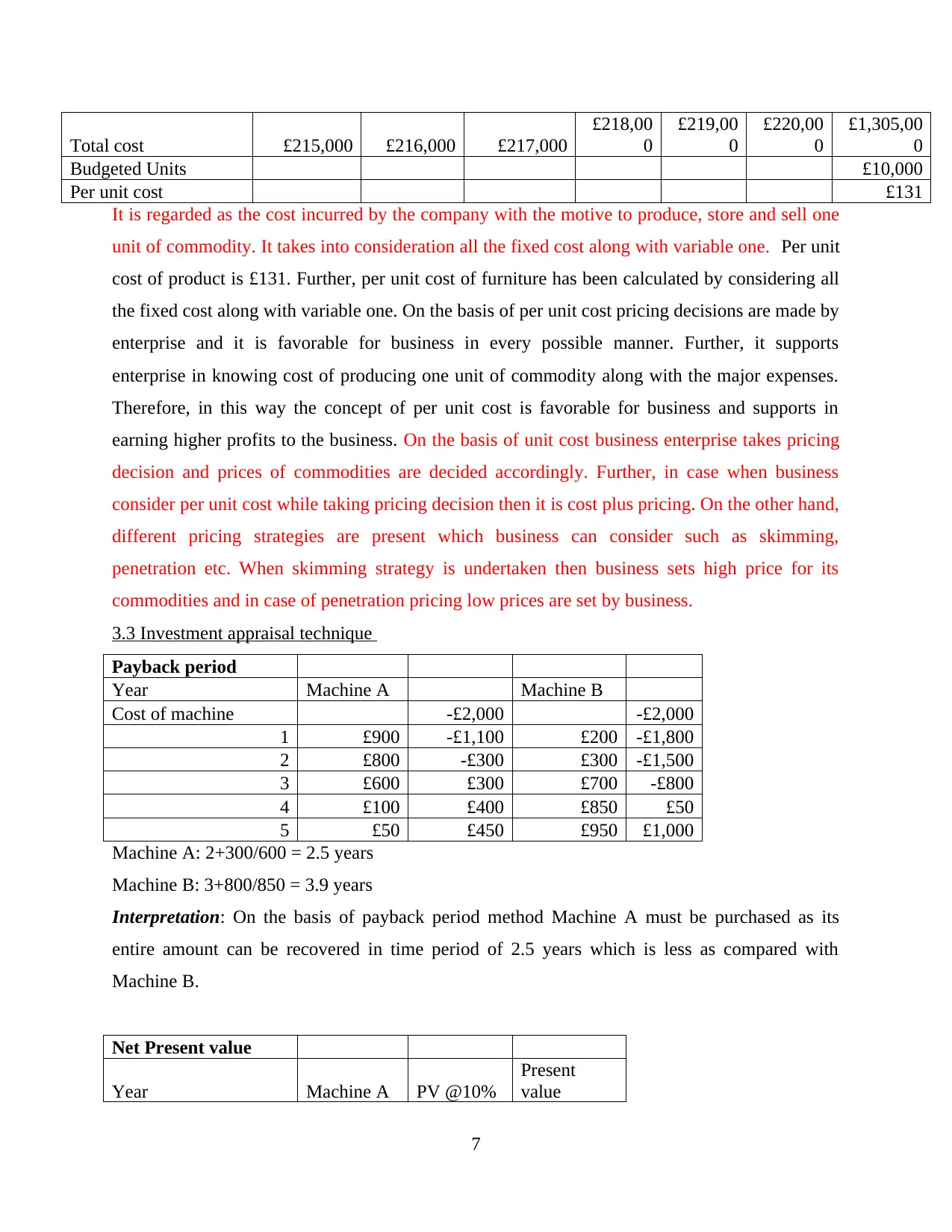
Total cost £215,000 £216,000 £217,000
£218,00
0
£219,00
0
£220,00
0
£1,305,00
0
Budgeted Units £10,000
Per unit cost £131
It is regarded as the cost incurred by the company with the motive to produce, store and sell one
unit of commodity. It takes into consideration all the fixed cost along with variable one. Per unit
cost of product is £131. Further, per unit cost of furniture has been calculated by considering all
the fixed cost along with variable one. On the basis of per unit cost pricing decisions are made by
enterprise and it is favorable for business in every possible manner. Further, it supports
enterprise in knowing cost of producing one unit of commodity along with the major expenses.
Therefore, in this way the concept of per unit cost is favorable for business and supports in
earning higher profits to the business. On the basis of unit cost business enterprise takes pricing
decision and prices of commodities are decided accordingly. Further, in case when business
consider per unit cost while taking pricing decision then it is cost plus pricing. On the other hand,
different pricing strategies are present which business can consider such as skimming,
penetration etc. When skimming strategy is undertaken then business sets high price for its
commodities and in case of penetration pricing low prices are set by business.
3.3 Investment appraisal technique
Payback period
Year Machine A Machine B
Cost of machine -£2,000 -£2,000
1 £900 -£1,100 £200 -£1,800
2 £800 -£300 £300 -£1,500
3 £600 £300 £700 -£800
4 £100 £400 £850 £50
5 £50 £450 £950 £1,000
Machine A: 2+300/600 = 2.5 years
Machine B: 3+800/850 = 3.9 years
Interpretation: On the basis of payback period method Machine A must be purchased as its
entire amount can be recovered in time period of 2.5 years which is less as compared with
Machine B.
Net Present value
Year Machine A PV @10%
Present
value
7
£218,00
0
£219,00
0
£220,00
0
£1,305,00
0
Budgeted Units £10,000
Per unit cost £131
It is regarded as the cost incurred by the company with the motive to produce, store and sell one
unit of commodity. It takes into consideration all the fixed cost along with variable one. Per unit
cost of product is £131. Further, per unit cost of furniture has been calculated by considering all
the fixed cost along with variable one. On the basis of per unit cost pricing decisions are made by
enterprise and it is favorable for business in every possible manner. Further, it supports
enterprise in knowing cost of producing one unit of commodity along with the major expenses.
Therefore, in this way the concept of per unit cost is favorable for business and supports in
earning higher profits to the business. On the basis of unit cost business enterprise takes pricing
decision and prices of commodities are decided accordingly. Further, in case when business
consider per unit cost while taking pricing decision then it is cost plus pricing. On the other hand,
different pricing strategies are present which business can consider such as skimming,
penetration etc. When skimming strategy is undertaken then business sets high price for its
commodities and in case of penetration pricing low prices are set by business.
3.3 Investment appraisal technique
Payback period
Year Machine A Machine B
Cost of machine -£2,000 -£2,000
1 £900 -£1,100 £200 -£1,800
2 £800 -£300 £300 -£1,500
3 £600 £300 £700 -£800
4 £100 £400 £850 £50
5 £50 £450 £950 £1,000
Machine A: 2+300/600 = 2.5 years
Machine B: 3+800/850 = 3.9 years
Interpretation: On the basis of payback period method Machine A must be purchased as its
entire amount can be recovered in time period of 2.5 years which is less as compared with
Machine B.
Net Present value
Year Machine A PV @10%
Present
value
7
⊘ This is a preview!⊘
Do you want full access?
Subscribe today to unlock all pages.

Trusted by 1+ million students worldwide
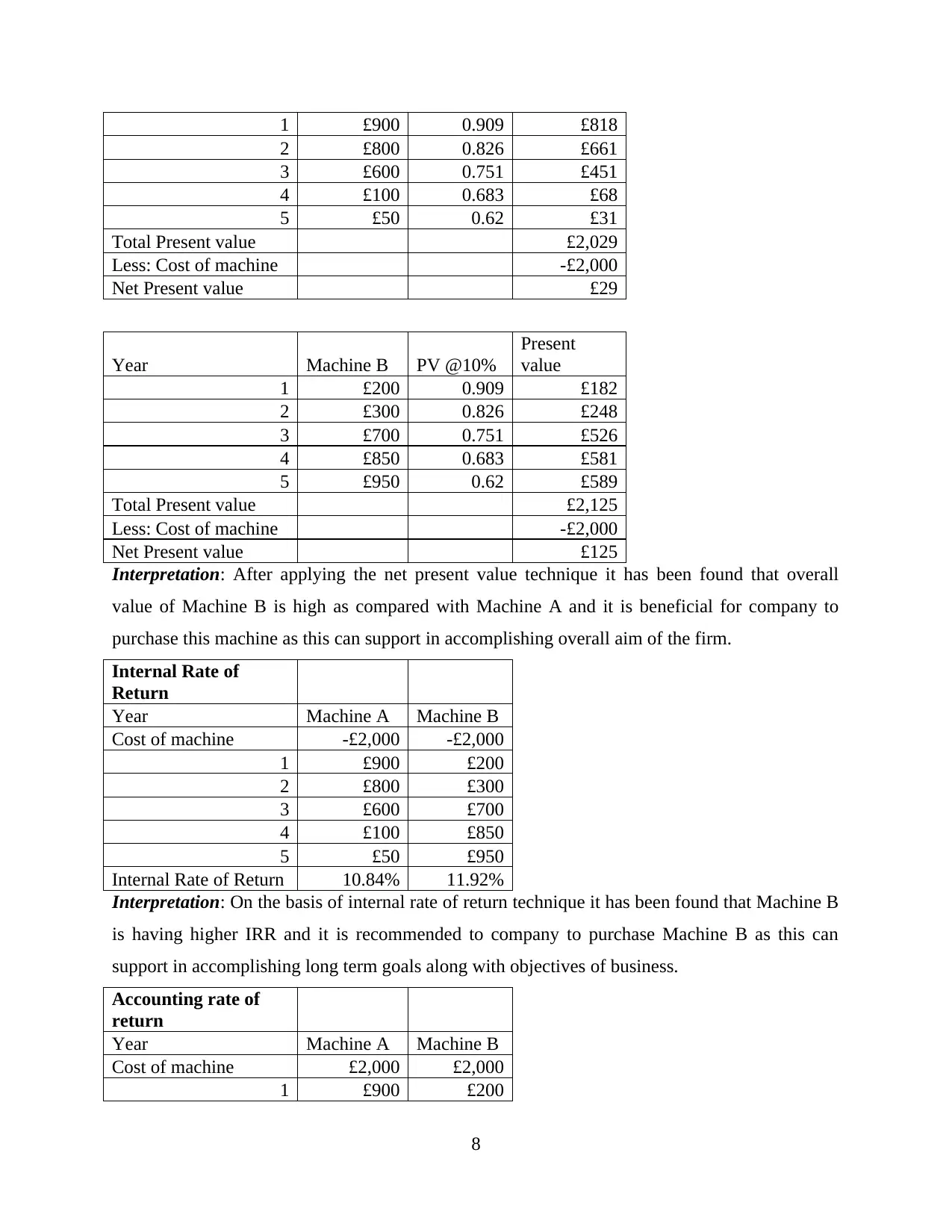
1 £900 0.909 £818
2 £800 0.826 £661
3 £600 0.751 £451
4 £100 0.683 £68
5 £50 0.62 £31
Total Present value £2,029
Less: Cost of machine -£2,000
Net Present value £29
Year Machine B PV @10%
Present
value
1 £200 0.909 £182
2 £300 0.826 £248
3 £700 0.751 £526
4 £850 0.683 £581
5 £950 0.62 £589
Total Present value £2,125
Less: Cost of machine -£2,000
Net Present value £125
Interpretation: After applying the net present value technique it has been found that overall
value of Machine B is high as compared with Machine A and it is beneficial for company to
purchase this machine as this can support in accomplishing overall aim of the firm.
Internal Rate of
Return
Year Machine A Machine B
Cost of machine -£2,000 -£2,000
1 £900 £200
2 £800 £300
3 £600 £700
4 £100 £850
5 £50 £950
Internal Rate of Return 10.84% 11.92%
Interpretation: On the basis of internal rate of return technique it has been found that Machine B
is having higher IRR and it is recommended to company to purchase Machine B as this can
support in accomplishing long term goals along with objectives of business.
Accounting rate of
return
Year Machine A Machine B
Cost of machine £2,000 £2,000
1 £900 £200
8
2 £800 0.826 £661
3 £600 0.751 £451
4 £100 0.683 £68
5 £50 0.62 £31
Total Present value £2,029
Less: Cost of machine -£2,000
Net Present value £29
Year Machine B PV @10%
Present
value
1 £200 0.909 £182
2 £300 0.826 £248
3 £700 0.751 £526
4 £850 0.683 £581
5 £950 0.62 £589
Total Present value £2,125
Less: Cost of machine -£2,000
Net Present value £125
Interpretation: After applying the net present value technique it has been found that overall
value of Machine B is high as compared with Machine A and it is beneficial for company to
purchase this machine as this can support in accomplishing overall aim of the firm.
Internal Rate of
Return
Year Machine A Machine B
Cost of machine -£2,000 -£2,000
1 £900 £200
2 £800 £300
3 £600 £700
4 £100 £850
5 £50 £950
Internal Rate of Return 10.84% 11.92%
Interpretation: On the basis of internal rate of return technique it has been found that Machine B
is having higher IRR and it is recommended to company to purchase Machine B as this can
support in accomplishing long term goals along with objectives of business.
Accounting rate of
return
Year Machine A Machine B
Cost of machine £2,000 £2,000
1 £900 £200
8
Paraphrase This Document
Need a fresh take? Get an instant paraphrase of this document with our AI Paraphraser
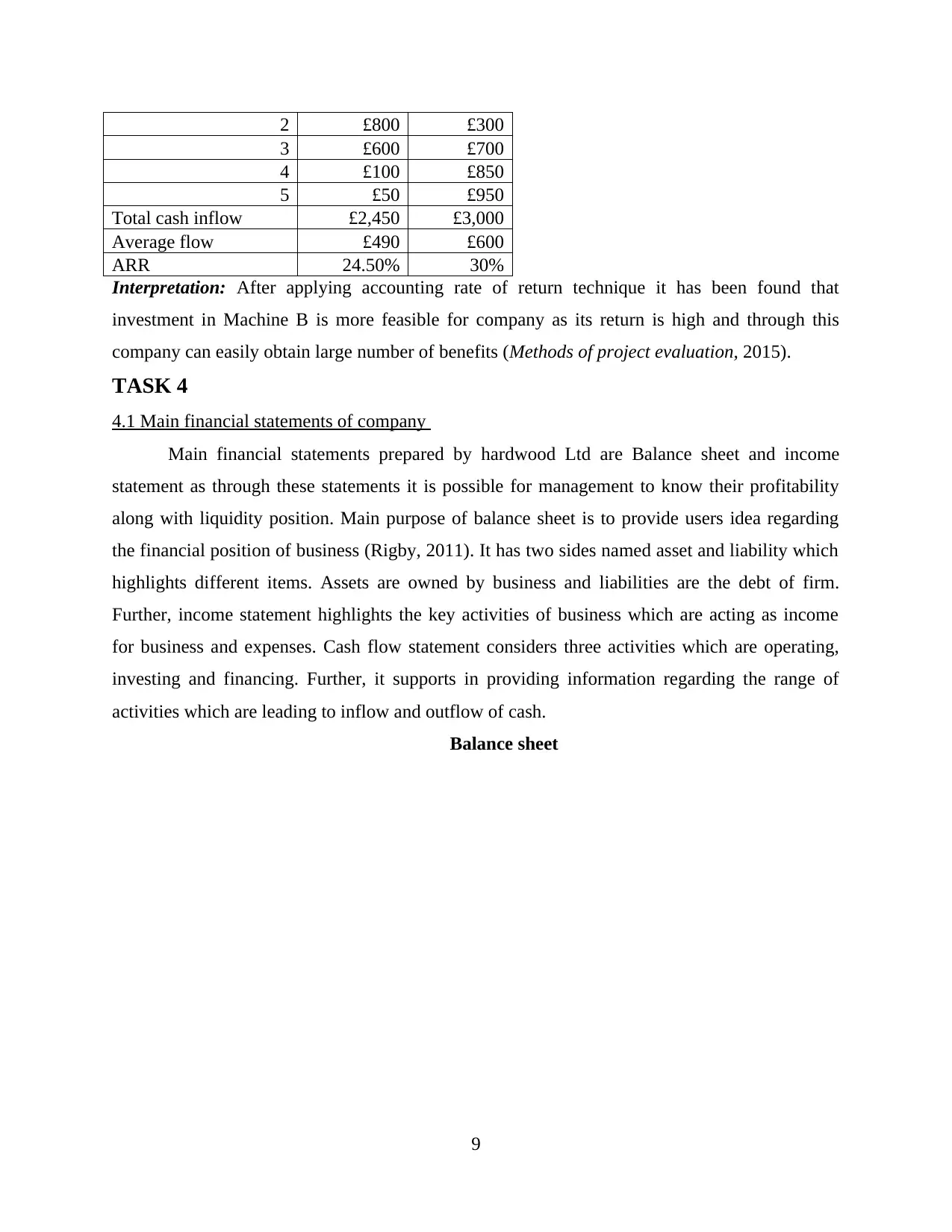
2 £800 £300
3 £600 £700
4 £100 £850
5 £50 £950
Total cash inflow £2,450 £3,000
Average flow £490 £600
ARR 24.50% 30%
Interpretation: After applying accounting rate of return technique it has been found that
investment in Machine B is more feasible for company as its return is high and through this
company can easily obtain large number of benefits (Methods of project evaluation, 2015).
TASK 4
4.1 Main financial statements of company
Main financial statements prepared by hardwood Ltd are Balance sheet and income
statement as through these statements it is possible for management to know their profitability
along with liquidity position. Main purpose of balance sheet is to provide users idea regarding
the financial position of business (Rigby, 2011). It has two sides named asset and liability which
highlights different items. Assets are owned by business and liabilities are the debt of firm.
Further, income statement highlights the key activities of business which are acting as income
for business and expenses. Cash flow statement considers three activities which are operating,
investing and financing. Further, it supports in providing information regarding the range of
activities which are leading to inflow and outflow of cash.
Balance sheet
9
3 £600 £700
4 £100 £850
5 £50 £950
Total cash inflow £2,450 £3,000
Average flow £490 £600
ARR 24.50% 30%
Interpretation: After applying accounting rate of return technique it has been found that
investment in Machine B is more feasible for company as its return is high and through this
company can easily obtain large number of benefits (Methods of project evaluation, 2015).
TASK 4
4.1 Main financial statements of company
Main financial statements prepared by hardwood Ltd are Balance sheet and income
statement as through these statements it is possible for management to know their profitability
along with liquidity position. Main purpose of balance sheet is to provide users idea regarding
the financial position of business (Rigby, 2011). It has two sides named asset and liability which
highlights different items. Assets are owned by business and liabilities are the debt of firm.
Further, income statement highlights the key activities of business which are acting as income
for business and expenses. Cash flow statement considers three activities which are operating,
investing and financing. Further, it supports in providing information regarding the range of
activities which are leading to inflow and outflow of cash.
Balance sheet
9
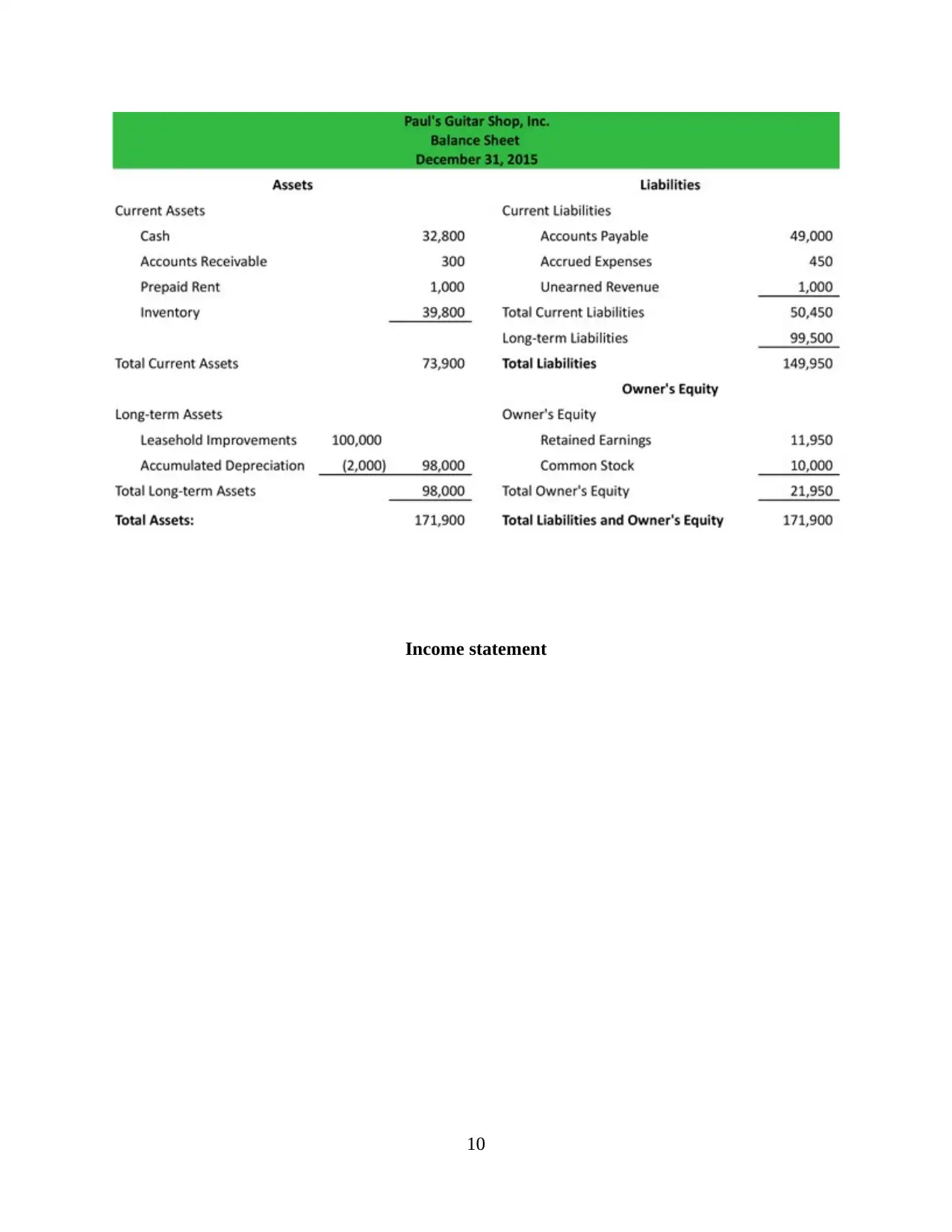
Income statement
10
10
⊘ This is a preview!⊘
Do you want full access?
Subscribe today to unlock all pages.

Trusted by 1+ million students worldwide
1 out of 18
Related Documents
Your All-in-One AI-Powered Toolkit for Academic Success.
+13062052269
info@desklib.com
Available 24*7 on WhatsApp / Email
![[object Object]](/_next/static/media/star-bottom.7253800d.svg)
Unlock your academic potential
Copyright © 2020–2025 A2Z Services. All Rights Reserved. Developed and managed by ZUCOL.





